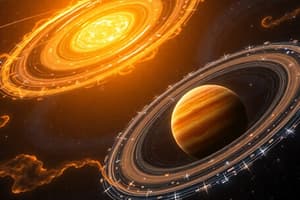Podcast
Questions and Answers
Which theory suggests that planets were formed from debris resulting from a collision between the sun and a giant comet?
Which theory suggests that planets were formed from debris resulting from a collision between the sun and a giant comet?
- Kant-Laplace Nebular Theory
- Descartes Vortex Theory
- Buffon’s Collision Theory (correct)
- Solar Nebular Theory
What is a key aspect of the Kant-Laplace Nebular Theory?
What is a key aspect of the Kant-Laplace Nebular Theory?
- Formation from a giant comet
- Gravitational collapse of a gas and dust cloud (correct)
- Electrostatic forces in planet formation
- Radiometric dating
What are terrestrial planets?
What are terrestrial planets?
Mercury, Venus, Earth, Mars
What are gas giants?
What are gas giants?
Geologic time scale represents the actual ages of geological events.
Geologic time scale represents the actual ages of geological events.
Which principle states that the bottom layer of sedimentary rocks is the oldest?
Which principle states that the bottom layer of sedimentary rocks is the oldest?
The age of one object compared to the age of another is known as __________ dating.
The age of one object compared to the age of another is known as __________ dating.
What does absolute dating assign to geological events?
What does absolute dating assign to geological events?
Half-life is the amount of time needed for half of the parent atoms in a sample to be changed into __________ products.
Half-life is the amount of time needed for half of the parent atoms in a sample to be changed into __________ products.
How do scientists determine the age of rocks using carbon dating?
How do scientists determine the age of rocks using carbon dating?
Match the dating methods with their descriptions:
Match the dating methods with their descriptions:
Flashcards are hidden until you start studying
Study Notes
Theories on the Origin of the Solar System
- Descartes Vortex Theory: Proposes that the universe consists of matter settled into vortices, forming celestial bodies with circular orbits due to whirlpool-like motion.
- Buffon’s Collision Theory: Suggests planets originated from a collision between the sun and a giant comet, with resultant debris forming planets rotating in the same direction around the sun.
- Jean-Jeffreys Tidal Theory: Claims planets were formed from materials torn from the sun when a massive star passed nearby, causing gravitational attraction to pull off substances.
- Kant-Laplace Nebular Theory: Describes the collapse of a gas and dust cloud (nebula) due to gravitational forces, leading to increased rotation and flattening into a disk shape with a bulging center.
- Solar Nebular Theory:
- Initiated by the formation of a nebula of hydrogen and helium.
- Collapse of the nebula results in regions of higher density, influenced by external events like supernovae.
- Leads to the formation of a protostar, protoplanetary disks, and planetesimals, ultimately creating planets and larger celestial bodies.
- The sun ignites as the protostar’s core becomes denser and hotter.
Classification of Planets
- Terrestrial Planets: Includes Mercury, Venus, Earth, and Mars; formed from solid particles and have smaller sizes. Solar winds stripped away gases and dust.
- Gas Giants/Jovian Planets: Includes Jupiter, Saturn, Uranus, and Neptune; formed from gaseous particles, larger in size, and able to retain atmospheric gases.
Earth: History and Geologic Time
- Earth's history begins with Solar System formation and is described through geologic time, reconstructed from studies of rocks, layers, and fossils.
- Geologic Time Scale: Represents Earth's geological history; scientists use relative and absolute dating methods to determine the timing of events.
Relative Dating Principles
- Principle of Original Horizontality: Sedimentary rocks are deposited in horizontal layers.
- Principle of Superposition: In a sequence of sedimentary rocks, the bottom layer is the oldest, with successive layers being younger.
- Principle of Cross-cutting Relationships: Geological features like faults are younger than the materials they cut through.
- Principle of Inclusion: Rock fragments included in a layer must be older than the layer containing them.
Index Fossils and Absolute Dating
- Index fossils are widespread, rapid in lifespan, abundant, and easily recognizable, aiding in dating rock layers.
- Absolute Dating: Assigns actual dates to rocks or geological events.
- Radiometric Dating: Measures radioactive decay of atomic nuclei, determining age based on parent and daughter products.
- Radiocarbon Dating: Measures remaining carbon-14 in deceased organisms to establish age, based on decay rates.
Subsystems of the Earth
- Earth is dynamic and interconnected, comprising various subsystems that continuously interact.
- Atmosphere: A layer of gases surrounding Earth, essential for providing air to breathe and regulating climate.
Studying That Suits You
Use AI to generate personalized quizzes and flashcards to suit your learning preferences.




